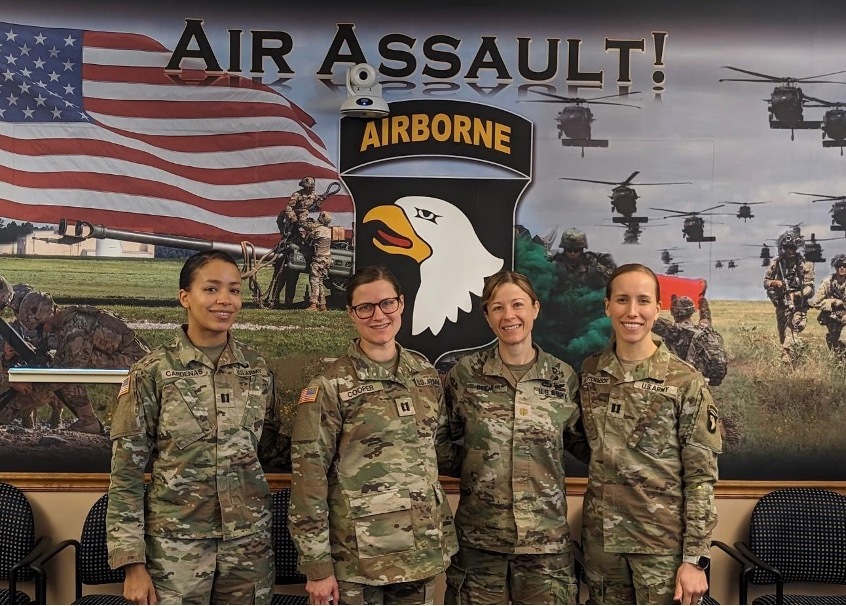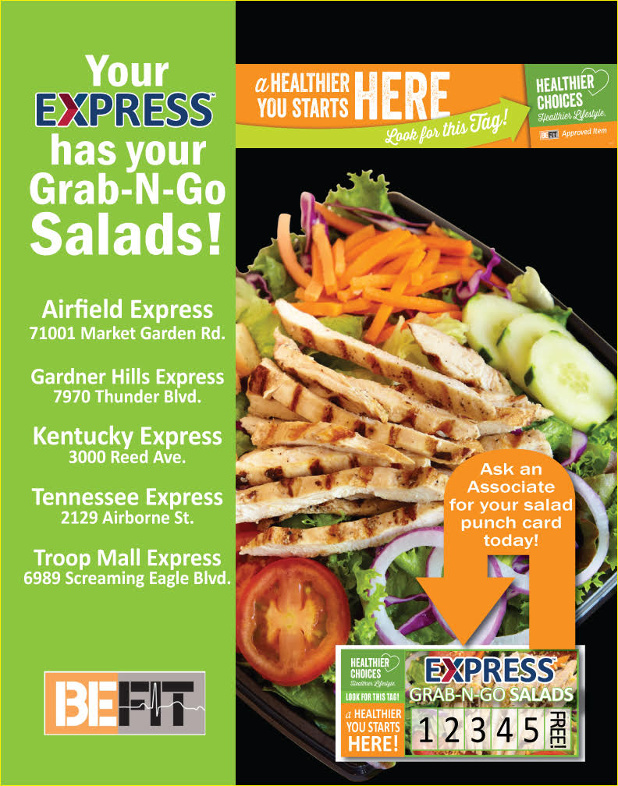 H2F Dietitians after briefing mNEAT to 101st Airborne (Air Assault) Division Senior Leaders. Left to right: CPT Anna Cardenas, CPT Jessica Cooper, MAJ Christina Deehl, and CPT Brooke Guttormson
Fort Campbell, KY RDs Enhance the Nutrition Environment
During our monthly Registered Dietitian (RD) meetings, it became apparent that the garrison’s food environment needed significant improvements to promote health and performance. Our patients shared a consistent theme –inadequate healthy and convenient food options on base made unhealthy food options the “easy”choice. We decided to take action to assess and improve the local nutrition environment by taking the following steps:
PREPARE
- Wrote a Division OPORD tasking an mNEAT assessment across Fort Campbell—official channels helped gain command visibility and ensure each subordinate Brigade and Hospital Commands understood their RDs’ roles in the process
- Divided the food venues among the RDs and assessed 30 venues total
ASSESS
- Used Military Nutrition Environment Assessment Tool (mNEAT) and accessed resources on Human Performance Resources by CHAMP (HPRC)
- Reviewed scores and found Fort Campbell’s scores were lower than the Army average in every venue category
COMMUNICATE
- Briefed the initial results to the Division Deputy Commander, who was highly invested in seeing progress and provided guidance
PLAN & TAKE ACTION
- Developed action plans
- Met with key stakeholders (MWR director and managers, commissary director, AAFES managers, division and brigade foodservice leaders, and Commanders Ready and Resilient Council (CR2C) lead) to finalize action plans (details below):
DFACs
The Division Senior Food Advisor published an OPORD mandating at least 80% of DFAC staff receive G4G training. The percentage of trained staff rose from approximately 40% to 80% in just 2 months. Post-training, the cooks had an understanding of the color-coded labels, choice architecture, and food availability issues, helping improve most of the lower scoring areas of the mNEAT assessments. RDs also became more involved in their respective DFACs, fostering greater collaboration with their foodservice counterparts.
We started a meal prep program prior to completing the mNEAT and it has been hugely successful. It’s for both meal and non-meal cardholders with a menu designed by H2F RDs and made in the DFACs. Due to its popularity, the Division Command wants to expand it.
AAFES venues
In the food courts, AAFES incentivized healthy options with punch cards and price reductions for salads. AAFES convenience stores updated their layouts to place healthier options at the front of the store, making those purchases more convenient. In the long term, the RDs plan to remain tied in with U.S. Army Installation Management Command (IMCOM) so we can ensure healthier options when new contracted food venues come to base.
 |
AAFES Healthy Initiatives
MWR facilities
The MWR Warrior Zone updated its menus by adding options such as “naked wings” and salads. They also restructured their menus to list healthy options first. Improvements in the bowling alley are in progress.
Commissary
The commissary highlighted the Dietitian Approved Thumb logo on healthy options and added healthier choices near the checkout line. They also educated staff on the healthier options to provide assistance to patrons.
Finally, RDs briefed mNEAT reports, action plans, and initial progress to CR2C and the 101st Division Commanding General. MG Sylvia gave accolades to the 13 Fort Campbell RDs for this initiative. He also pledged his support to continue nutrition environment improvements and promote health and fitness in 101st Soldiers and their families.
MONITOR & EVALUATE
Six months after the initial assessment, we plan to reassess the food environment using mNEAT and then bi-annually thereafter to ensure we are staying on track.
|